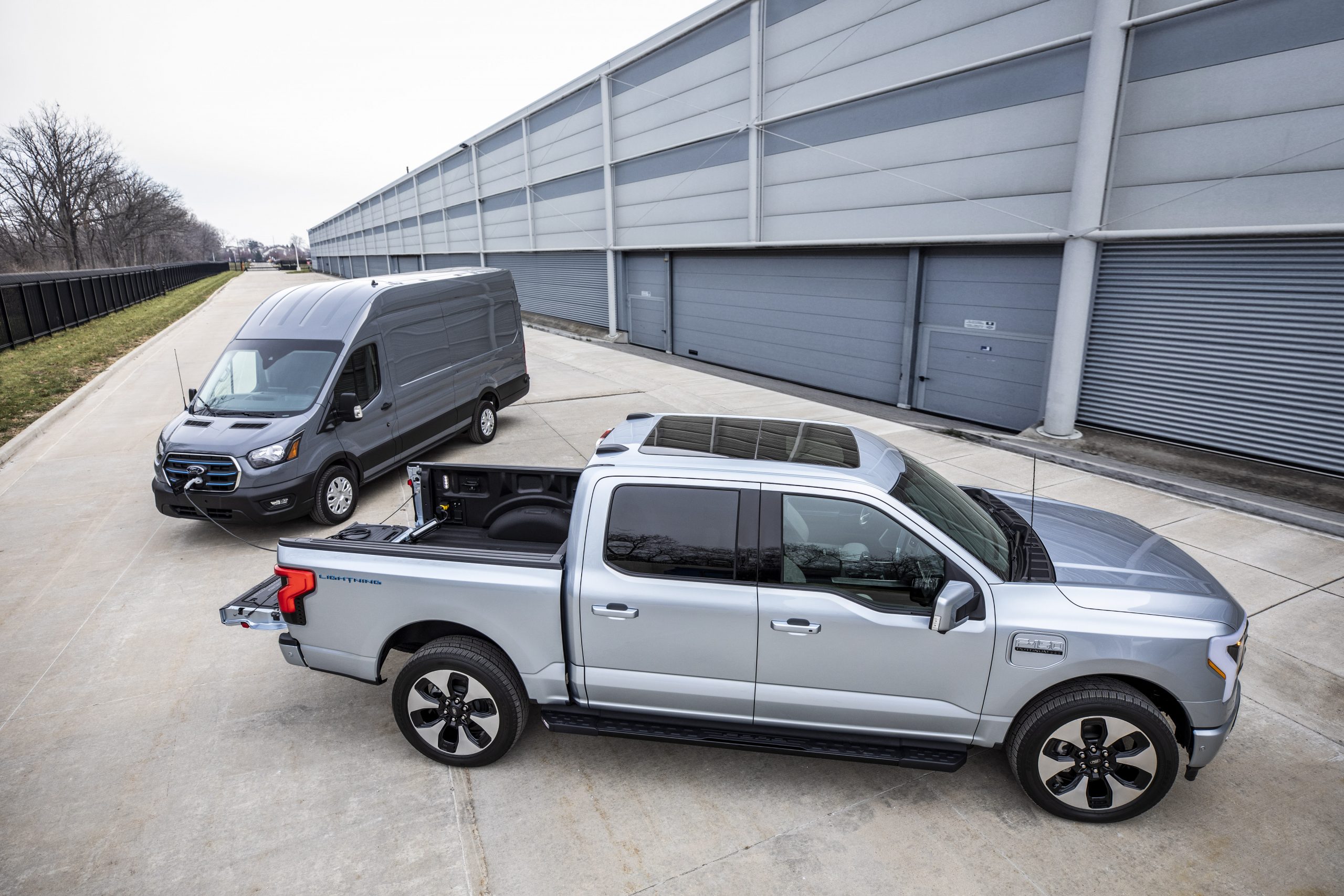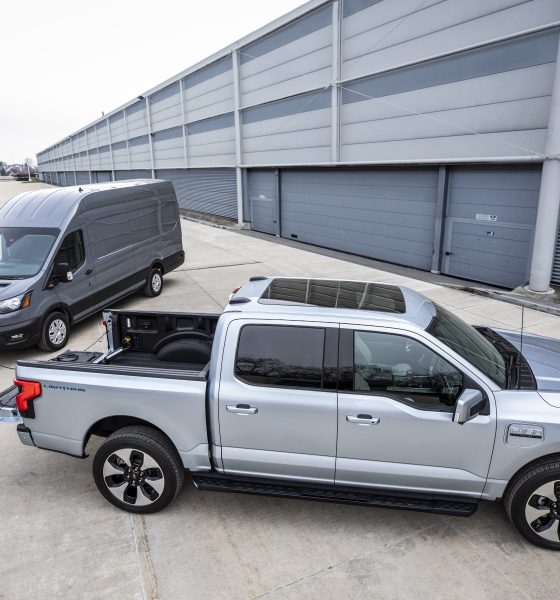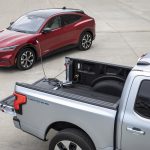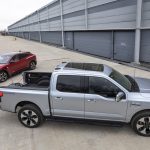

News
Ford shows its awesome Vehicle-to-Vehicle Charging with F-150 Lightning
Thanks to Ford’s Pro Power Onboard system, the 2022 F-150 Lightning, the all-electric version of the United States’ best-selling pickup truck, owners will now have the ability to share range with other EVs.
The feature is exclusive to the Ford F-150 Lightning and F-150 PowerBoost Hybrid, which both equip Pro Power Onboard. The feature essentially turns the vehicles into mobile charging stations for other EVs, as the onboard generators and high-capacity battery systems holding the charge can now give other cars additional range by simply plugging into the host vehicle. It’s not just exclusive for Ford, either, as the company stated in a press release announcing the feature that electric vehicles built by other manufacturers would also benefit from the feature.
- Aftermarket equipment shown. Preproduction Ford F-150 Lightning with optional equipment shown. Available starting spring 2022
- Aftermarket equipment shown. Preproduction Ford F-150 Lightning with optional equipment shown. Available starting spring 2022
- Aftermarket equipment shown. Ford E-Transit available early 2022. Preproduction Ford F-150 Lightning with optional equipment shown. Available starting spring 2022
The process is simple: Connect to an F-150 Lightning or F-150 PowerBoost Hybrid with the optional 9.6 or 7.2 kilowatt Pro Power Onboard feature. By using Ford’s Mobile Power Cord, the vehicle can deliver a Level-2 charging rate that will add an estimated 20 miles of range per hour. This figure was obtained by testing the feature with the Mustang Mach-E, Ford says. The Mach-E that was used to assess the performance of Pro Power Onboard equipped an extended-range battery and rear-wheel-drive. When using the feature with an F-150 Lightning, 13 miles of range was added. 10 additional miles were recorded in an hour with the Ford E-Transit low-roof cargo van. While this doesn’t sound like much, EV charging stations are becoming more available with every passing day. Even a quick charge of 45 minutes would likely get most people with completely depleted vehicles enough range to make it to their closest charging station.
Ford details more about the process for charging vehicles with Pro Power Onboard:
“Customers can easily take advantage of this capability, using a widely available power adaptor to link the Ford Mobile Power Cord to their truck. Once connected to the 240-volt Pro Power Onboard outlet, customers can use the Mobile Power Cord to charge a range of all-electric vehicles that use the SAE J1772 charge port. This includes the Ford Mustang Mach-E, the Ford E-Transit electric van and the all-new 2022 Ford F-150 Lightning electric pickup, as well as vehicles from other manufacturers.”
Ford F-150 Lightning unveiled: Price, Release date, Range, Features and more
The F-150 Lightning’s versatility as a power source opens the door for the vehicle to do more than just give owners a sustainable pickup. Ford’s Intelligent Backup Power could also be used to bring lights back on inside a home, essentially acting as an energy storage device.
“There are so many new opportunities to innovate with features and functions made possible only through electrification,” Patrick Soderborg, Ford E-Powertrain Systems Engineer, said. “This really hit home during the Texas power crisis last February, which left millions in the cold. F-150 Hybrid helped many Texans keep warm and powered up during those difficult times thanks to Pro Power Onboard – and we’re trying to do even more with F-150 Lightning.”
I’d love to hear from you! If you have any comments, concerns, or questions, please email me at joey@teslarati.com. You can also reach me on Twitter @KlenderJoey, or if you have news tips, you can email us at tips@teslarati.com.

Elon Musk
Elon Musk’s X will start using a Tesla-like software update strategy
The initiative seems designed to accelerate updates to the social media platform, while maintaining maximum transparency.

Elon Musk’s social media platform X will adopt a Tesla-esque approach to software updates for its algorithm.
The initiative seems designed to accelerate updates to the social media platform, while maintaining maximum transparency.
X’s updates to its updates
As per Musk in a post on X, the social media company will be making a new algorithm to determine what organic and advertising posts are recommended to users. These updates would then be repeated every four weeks.
“We will make the new 𝕏 algorithm, including all code used to determine what organic and advertising posts are recommended to users, open source in 7 days. This will be repeated every 4 weeks, with comprehensive developer notes, to help you understand what changed,” Musk wrote in his post.
The initiative somewhat mirrors Tesla’s over-the-air update model, where vehicle software is regularly refined and pushed to users with detailed release notes. This should allow users to better understand the details of X’s every update and foster a healthy feedback loop for the social media platform.
xAI and X
X, formerly Twitter, has been acquired by Elon Musk’s artificial intelligence startup, xAI last year. Since then, xAI has seen a rapid rise in valuation. Following the company’s the company’s upsized $20 billion Series E funding round, estimates now suggest that xAI is worth tens about $230 to $235 billion. That’s several times larger than Tesla when Elon Musk received his controversial 2018 CEO Performance Award.
As per xAI, the Series E funding round attracted a diverse group of investors, including Valor Equity Partners, Stepstone Group, Fidelity Management & Research Company, Qatar Investment Authority, MGX, and Baron Capital Group, among others. Strategic partners NVIDIA and Cisco Investments also continued support for building the world’s largest GPU clusters.
News
Tesla FSD Supervised wins MotorTrend’s Best Driver Assistance Award
The decision marks a notable reversal for the publication from prior years, with judges citing major real-world improvements that pushed Tesla’s latest FSD software ahead of every competing ADAS system.

Tesla’s Full Self-Driving (Supervised) system has been named the best driver-assistance technology on the market, earning top honors at the 2026 MotorTrend Best Tech Awards.
The decision marks a notable reversal for the publication from prior years, with judges citing major real-world improvements that pushed Tesla’s latest FSD software ahead of every competing ADAS system. And it wasn’t even close.
MotorTrend reverses course
MotorTrend awarded Tesla FSD (Supervised) its 2026 Best Tech Driver Assistance title after extensive testing of the latest v14 software. The publication acknowledged that it had previously criticized earlier versions of FSD for erratic behavior and near-miss incidents, ultimately favoring rivals such as GM’s Super Cruise in earlier evaluations.
According to MotorTrend, the newest iteration of FSD resolved many of those shortcomings. Testers said v14 showed far smoother behavior in complex urban scenarios, including unprotected left turns, traffic circles, emergency vehicles, and dense city streets. While the system still requires constant driver supervision, judges concluded that no other advanced driver-assistance system currently matches its breadth of capability.
Unlike rival systems that rely on combinations of cameras, radar, lidar, and mapped highways, Tesla’s FSD operates using a camera-only approach and is capable of driving on city streets, rural roads, and freeways. MotorTrend stated that pure utility, the ability to handle nearly all road types, ultimately separated FSD from competitors like Ford BlueCruise, GM Super Cruise, and BMW’s Highway Assistant.
High cost and high capability
MotorTrend also addressed FSD’s pricing, which remains significantly higher than rival systems. Tesla currently charges $8,000 for a one-time purchase or $99 per month for a subscription, compared with far lower upfront and subscription costs from other automakers. The publication noted that the premium is justified given FSD’s unmatched scope and continuous software evolution.
Safety remained a central focus of the evaluation. While testers reported collision-free operation over thousands of miles, they noted ongoing concerns around FSD’s configurable driving modes, including options that allow aggressive driving and speeds beyond posted limits. MotorTrend emphasized that, like all Level 2 systems, FSD still depends on a fully attentive human driver at all times.
Despite those caveats, the publication concluded that Tesla’s rapid software progress fundamentally reshaped the competitive landscape. For drivers seeking the most capable hands-on driver-assistance system available today, MotorTrend concluded Tesla FSD (Supervised) now stands alone at the top.
News
Elon Musk’s Grokipedia surges to 5.6M articles, almost 79% of English Wikipedia
The explosive growth marks a major milestone for the AI-powered online encyclopedia, which was launched by Elon Musk’s xAI just months ago.

Elon Musk’s Grokipedia has grown to an impressive 5,615,201 articles as of today, closing in on 79% of the English Wikipedia’s current total of 7,119,376 articles.
The explosive growth marks a major milestone for the AI-powered online encyclopedia, which was launched by Elon Musk’s xAI just months ago. Needless to say, it would only be a matter of time before Grokipedia exceeds English Wikipedia in sheer volume.
Grokipedia’s rapid growth
xAI’s vision for Grokipedia emphasizes neutrality, while Grok’s reasoning capabilities allow for fast drafting and fact-checking. When Elon Musk announced the initiative in late September 2025, he noted that Grokipedia would be an improvement to Wikipedia because it would be designed to avoid bias.
At the time, Musk noted that Grokipedia “is a necessary step towards the xAI goal of understanding the Universe.”
Grokipedia was launched in late October, and while xAI was careful to list it only as Version 0.1 at the time, the online encyclopedia immediately earned praise. Wikipedia co-founder Larry Sanger highlighted the project’s innovative approach, noting how it leverages AI to fill knowledge gaps and enable rapid updates. Netizens also observed how Grokipedia tends to present articles in a more objective manner compared to Wikipedia, which is edited by humans.
Elon Musk’s ambitious plans
With 5,615,201 total articles, Grokipedia has now grown to almost 79% of English Wikipedia’s article base. This is incredibly quick, though Grokipedia remains text-only for now. xAI, for its part, has now updated the online encyclopedia’s iteration to v0.2.
Elon Musk has shared bold ideas for Grokipedia, including sending a record of the entire knowledge base to space as part of xAI’s mission to preserve and expand human understanding. At some point, Musk stated that Grokipedia will be renamed to Encyclopedia Galactica, and it will be sent to the cosmos.
“When Grokipedia is good enough (long way to go), we will change the name to Encyclopedia Galactica. It will be an open source distillation of all knowledge, including audio, images and video. Join xAI to help build the sci-fi version of the Library of Alexandria!” Musk wrote, adding in a later post that “Copies will be etched in stone and sent to the Moon, Mars and beyond. This time, it will not be lost.”











